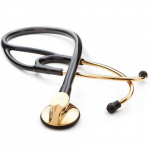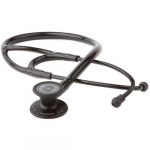Stethoscopes have a special metal listening device that captures sounds and transmits them via hollow rubber tubes to the doctor. Usually, this listening device has two sides - a flat one that transmits higher-frequency vibrations from the inside of the body, and a cup-shaped side that passes low-frequency skin vibrations. Purely mechanical stethoscopes produce very low volume sounds, therefore, electronic devices were invented. They can amplify the volume level and make it easier to inspect sounds. Some of these electronic gadgets can even record the sounds for later analysis. There are also Doppler stethoscopes, their working principle is based on the Doppler effect, these devices measure the internal ultrasound levels. Such gadgets are typically used for heart analysis. A separate type of such device is called fetal, it is used if you want to hear the sounds made by the fetus inside the abdomen.

























